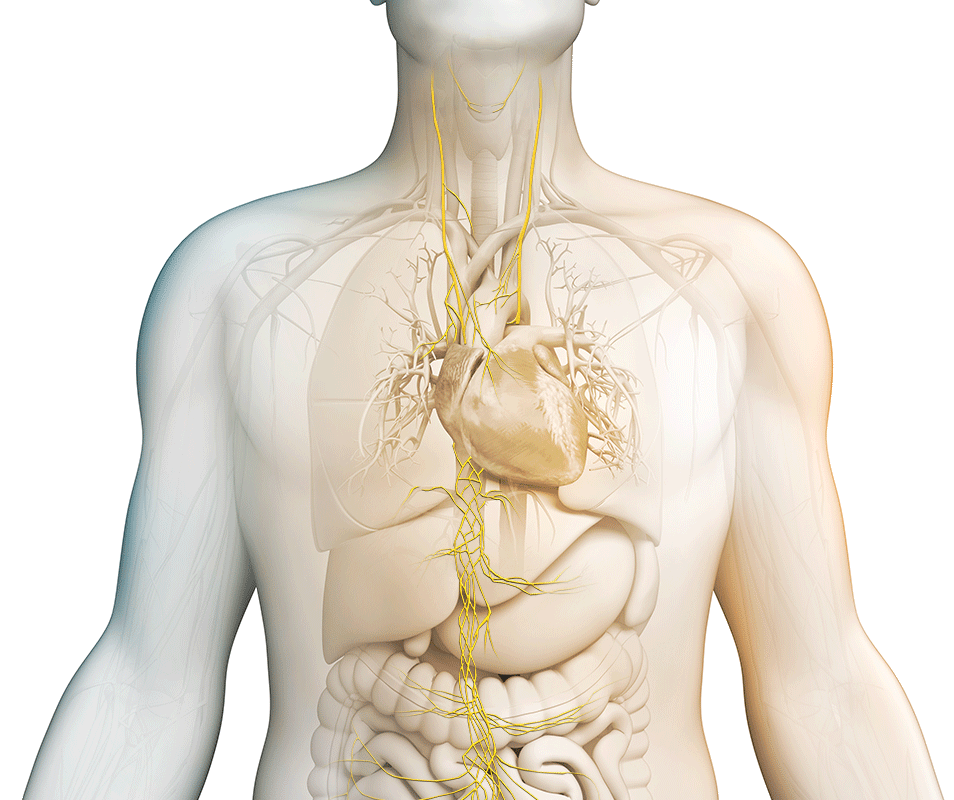By now you have probably heard the term “cytokine storm” as it relates to the Covid-19 virus. The “cytokine storm” is the inflammatory response that triggers acute respiratory distress syndrome (ARDS). In most of the Covid-19 cases, patients are dying from the respiratory failure that results from the inflammatory response; not the virus itself.
Some fantastic research has been in the works and/or is now underway evaluating the effectiveness of stimulating the vagus nerve to inhibit the “cytokine storm”. So, what is the vagus nerve?
The vagus nerve is the 10th cranial nerve and is the longest nerve in the autonomic nervous system responsible for some pretty important functions. The vagus nerve represents the main component of the parasympathetic nervous system overseeing many crucial bodily functions including control of mood, immune response, digestion, and heart rate. The vagus nerve sends signals via the parasympathetic nervous system to these organs instructing them when to perform. Vagal tone is the measure of the strength or weakness of the vagus nerve.
The vagus nerve can be stimulated through electrical stimulation via an implantable device placed on the vagus nerve or through a transcutaneous (tVNS) approach utilizing a clip on the ear. However, there’s another way to stimulate the vagus nerve all day long; it’s with your breath. In today’s world of dysfunctional breathing, most people have low vagal tone because the vagus nerve is not getting enough stimulation; if any at all.
The vagus nerve is also known as the “wandering” nerve because it wanders from the cranial nerves, throughout the body and eventually right through the Diaphragm muscle. The movement of the diaphragm stimulates the vagus nerve. So, the more movement in the diaphragm, the more stimulation of the vagus nerve and parasympathetic nervous system.
So, how do we stimulate the vagus nerve with our breath? With nasal diaphragmatic breathing which is something we all have access to at any given moment. Since more than 60% of our population are dysfunctional breathers, we typically mouth breathe and/or shallow breathe only using the upper portion of our lungs to breathe. This lack of proper breathing doesn’t engage the diaphragm muscle properly, therefore, the vagus nerve is not being stimulated NOR is the parasympathetic nervous system. In fact, mouth breathing and/or shallow nasal breathing signals the “stress” response in the body as stress response nerve endings are located in the upper lobes of the lungs.
The key to proper stimulation of the vagus nerve and strengthening vagal tone is the length, depth & pace of your breath rate and pattern. Specifically, we want to nasal diaphragmatically breathe at a rate of 10 breaths or less per minute. Most Americans are breathing at a rate of 15 breaths per minute or more. We breathe with a shallow inhale and barely engage in the exhale process.
Here’s some breathing 101 to help get you started. The inhale part of the breathing process is sympathetic in nature signaling the stress response system. The exhale is parasympathetic in nature signaling the parasympathetic nervous system. So, if we’re only inhaling to the upper portion of our lungs where the stress response nerve endings are housed AND we’re barely engaging in the exhale process, we’re breathing at a rapid rate living in the stress response.
To improve the length, depth and pace of our breathing, I love incorporating the ocean sounding breath with the diaphragmatic breath. I call this Optimal Diaphragmatic Breathing. Incorporating the ocean sounding breath, helps us to improve breathing rates and patterns while also creating a sound in the throat that sounds like the ocean. This sound also stimulates the vagus nerve as does humming.
Right now as the Covid-19 crisis is still in the forefront of our minds, maintaining our individual health and well-being is essential for navigating the world around us. It’s a great time to improve dysfunctional breathing which will have a positive effect on your health in many areas. Learning to improve breathing rates and patterns will reduce stress and anxiety, improve sleep health, heart health, upper respiratory health and so much more.
Discover your “life with breath” by applying “breath AS medicine.”
Go BE Great!


